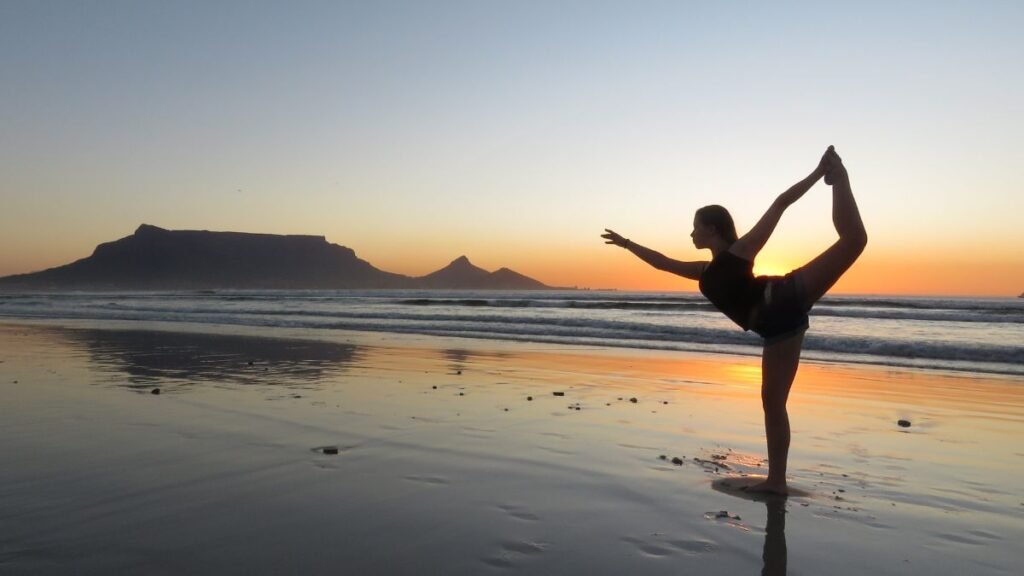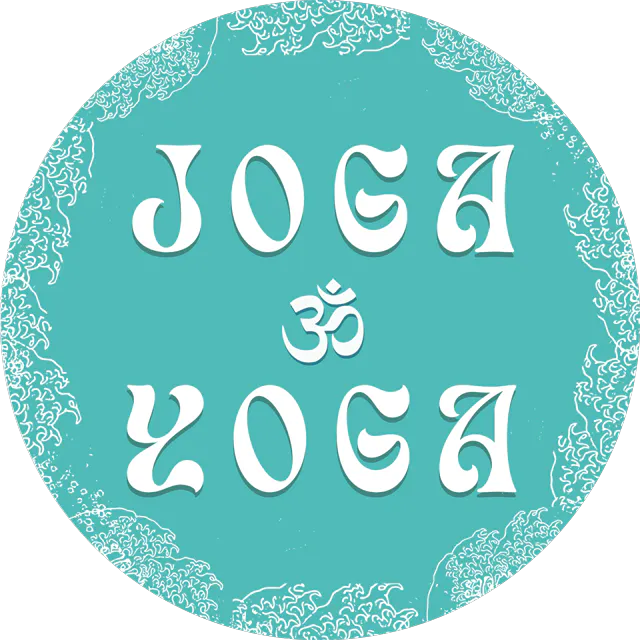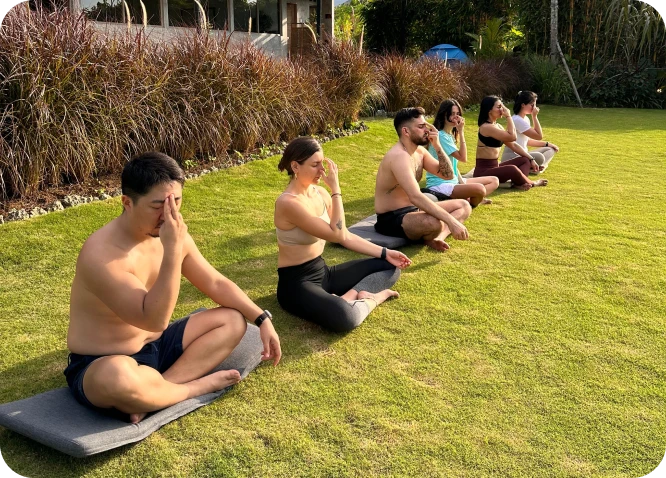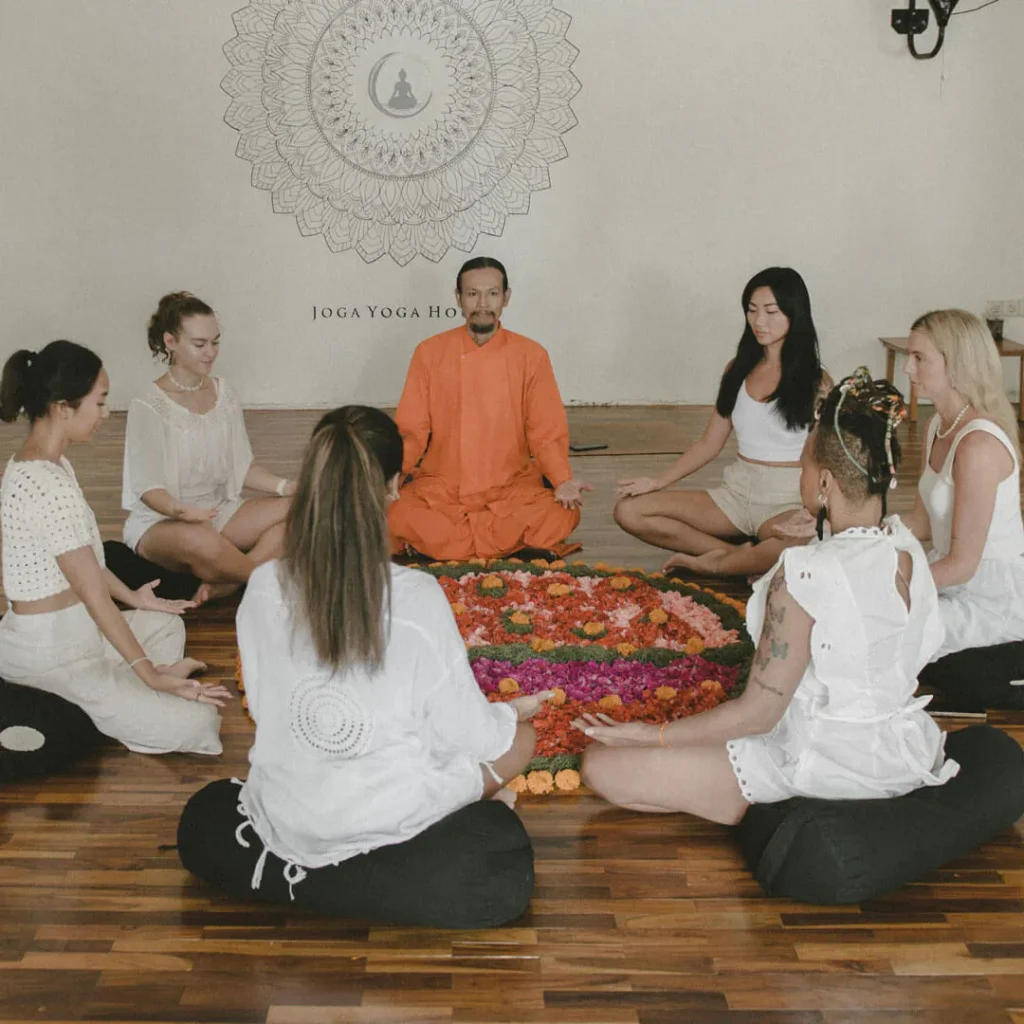Start Your Yoga Teacher Training in Bali
Looking to become a certified yoga teacher? Bali is one of the top global destinations for Yoga Teacher Training (YTT), offering Yoga Alliance-certified programs, experienced instructors, and breathtaking retreat centers.
Whether you’re looking for a 200-hour, 300-hour, or specialized training program, this guide will help you find the best Yoga Teacher Training in Bali. We’ll cover:
- Curriculum details
- Cost comparisons
- Certification options
- Insider tips to maximize your training experience
Why Choose Bali for Your Yoga Teacher Training?
Bali offers a unique combination of spiritual depth, cultural immersion, and high-quality yoga education.
✅ Deepen Your Practice – Learn asanas, meditation, and pranayama from world-class instructors.
✅ Global Certification – Ensure your training is Yoga Alliance-certified, allowing you to teach worldwide.
✅ Serene Retreat Environment – Train in Ubud’s jungle, Canggu’s beachside studios, or Uluwatu’s cliffside sanctuaries.
✅ Strong Yoga Community – Connect with like-minded yogis and establish lifelong relationships.
✅ Cultural Immersion – Participate in Balinese ceremonies, temple visits, and local wellness activities.
📽️ Want a sneak peek into what it’s like to train in Bali? Watch this video for a glimpse into the transformative experience:
Embark on a Life-Changing Yoga Journey
Starting a Yoga Teacher Training in Bali isn’t just about certification—it’s about growth, transformation, and immersion in an environment that nurtures body, mind, and spirit. Whether you’re a passionate yogi looking to refine your skills or someone aspiring to turn yoga into a career, Bali offers the perfect blend of education, community, and cultural experience.
🔗 Related Reading: How to Prepare for Your Upcoming Yoga Teacher Training in Bali
Types of Yoga Teacher Training Programs in Bali
Bali offers several YTT options, each designed to meet different experience levels and career aspirations.
| Program Type | Duration | Who It’s For? |
|---|---|---|
| 100-Hour YTT | 2 weeks | Beginners looking to deepen their practice without committing to full certification |
| 200-Hour YTT | 4 weeks | Standard certification course for those looking to start a career as a yoga teacher |
| 300-Hour YTT | 6-8 weeks | Advanced training for those who already hold a 200-hour certificate and want to enhance their expertise |
🔗 Related Reading: 200-Hour vs. 300-Hour Yoga Teacher Training in Bali: Which One is Right for You?



Core Curriculum: What You’ll Learn in a YTT Program
Every Yoga Teacher Training in Bali follows a structured core curriculum to ensure you receive a well-rounded education in yoga practice, teaching techniques, and philosophy.
1. Yoga Philosophy & Ethics
Gain a deeper understanding of ancient yogic texts, including:
- The Yoga Sutras of Patanjali – Understanding the Eight Limbs of Yoga
- Bhagavad Gita – Exploring yoga’s ethical and spiritual dimensions
- Modern Applications – How yogic philosophy applies to daily life and teaching
2. Anatomy & Physiology
Learn how the human body moves in yoga and how to teach safe, injury-free practices:
- Musculoskeletal System – How different asanas affect muscles & joints
- Breathwork & Nervous System – The science of pranayama for mental & physical balance
- Energy Anatomy – Understanding chakras, nadis, and the subtle body
3. Teaching Methodology & Practicum
Master the skills needed to become a confident and effective yoga instructor:
- Class Sequencing – Structuring a balanced and engaging yoga class
- Cueing Techniques – Using verbal and non-verbal cues effectively
- Adjustments & Modifications – Ensuring poses are accessible for all students
The Training Environment: Where Yoga Meets Tranquility in Bali
One of the most transformative aspects of Yoga Teacher Training in Bali is the immersive training environment. Unlike regular yoga classes, YTT programs in Bali take place in serene, picturesque retreat centers that enhance learning, self-reflection, and personal growth.
These environments are designed to help students fully disconnect from distractions and focus on deepening their practice and teaching skills.
Yoga Teacher Training Certification Process
Step-by-Step Guide to Getting Certified
✔ Step 1: Enrollment – Register for a 100, 200, or 300-hour YTT program.
✔ Step 2: Complete Required Training Hours – Engage in intensive learning and practice.
✔ Step 3: Practical Assessments – Teach real classes under instructor supervision.
✔ Step 4: Written Exams – Test your knowledge in yoga philosophy, anatomy, and methodology.
✔ Step 5: Graduation & Certification – Earn a Yoga Alliance-recognized certificate.
What to Expect from a Yoga Training Retreat in Bali
Most Yoga Teacher Training centers in Bali offer a blend of comfort, nature, and community, ensuring a well-rounded experience both on and off the mat.
| Feature | Why It Matters? |
|---|---|
| Spacious Yoga Studios | Open-air, nature-surrounded studios promote focus, relaxation, and connection to the environment. |
| Comfortable Accommodations | Options range from luxurious private villas to budget-friendly shared dormitories. |
| Nutritious Meals | Typically vegetarian or vegan meals designed to support a healthy, high-energy lifestyle. |
| Cultural Immersion | Participate in Balinese ceremonies, traditional dance, temple visits, and local excursions. |
Many retreat centers also offer meditation gardens, infinity pools, and wellness spas, making your YTT experience both rigorous and rejuvenating.
Meet the Instructors: Experts in Yoga & Holistic Wellness
Bali’s yoga instructors are some of the most experienced and diverse in the world, often bringing decades of expertise in multiple yoga traditions.
Most YTT programs feature instructors specializing in:
✅ Hatha & Vinyasa Yoga – Foundational practices focused on breath, alignment, and flow
✅ Ashtanga & Yin Yoga – Strength-building vs. deep-stretch restorative yoga
✅ Meditation & Pranayama – Breathwork techniques for mind-body balance
✅ Yoga Therapy & Ayurveda – Holistic healing approaches
These instructors not only teach yoga postures but also guide students in yogic philosophy, mindfulness, and teaching methodologies.
Many teacher trainers are Yoga Alliance E-RYT 500 certified, meaning they have thousands of teaching hours and extensive experience training new instructors.
🔗 Related Reading: What RYT 200, E-RYT 200, RYT 500, and E-RYT 500 Really Mean for Yoga Teachers
How to Get Certified: Yoga Teacher Training Certification Process
Step-by-Step Certification Journey
Becoming a certified yoga instructor in Bali requires completing a structured training process, including theory, practice, and teaching assessments.
- Step 1: Enrollment – Meet the program’s prerequisites and register for the course.
- Step 2: Complete Training Hours – Fulfill the required 100, 200, or 300 hours of instruction.
- Step 3: Practical Assessments – Teach practice classes and receive feedback from instructors.
- Step 4: Written Exams – Demonstrate understanding of yoga philosophy, anatomy, and methodology.
- Step 5: Graduation & Certification – Receive a Yoga Alliance-recognized certificate to start teaching worldwide.
Once certified, you can apply for Yoga Alliance registration, which is an internationally recognized standard for professional yoga teachers.
🔗 Related Reading: Yoga Alliance Certification 2024: Do You Really Need It?
Why Choose a Yoga Teacher Training in Bali?
Bali offers an unmatched combination of world-class training, spiritual immersion, and breathtaking scenery. Whether you choose Ubud, Canggu, or Uluwatu, you’ll experience:
✔ Expert instructors guiding you through yoga, meditation, and philosophy
✔ A supportive global yoga community that fosters personal and professional growth
✔ Cultural experiences that deepen your understanding of yoga beyond the physical practice
Now that you know about the training environment, let’s explore how to choose the best YTT program for you
Effective Strategies for Choosing the Right Yoga Teacher Training Program in Bali

Selecting the right Yoga Teacher Training (YTT) program is a crucial step in your journey to becoming a certified instructor. The experience can be life-changing, but with so many options available, it’s important to choose wisely.
A high-quality YTT program will provide:
✔ A strong foundation in yoga philosophy, anatomy, and teaching techniques
✔ Accredited certification (Yoga Alliance or other recognized bodies)
✔ Experienced instructors who guide your transformation
✔ A supportive community and an inspiring learning environment
Here’s a step-by-step guide to help you make an informed decision before enrolling in a Yoga Teacher Training program in Bali.
1. Research & Compare Different YTT Programs
Not all yoga teacher training programs are the same. Researching your options ensures you choose a course that aligns with your goals, budget, and learning style.
Key Questions to Ask:
- Does the curriculum cover yoga philosophy, anatomy, teaching methodology, and practical teaching experience?
- What styles of yoga are taught? (e.g., Hatha, Vinyasa, Ashtanga, Yin)
- Does the program include meditation, breathwork (pranayama), and alignment training?
- Is there a mentorship or post-training support for graduates?
2. Evaluate the Instructors
Your instructors play a vital role in shaping your experience. Look for certified and experienced teachers who bring a wealth of knowledge in yoga philosophy, teaching techniques, and holistic wellness.
What to Look For:
- RYT 200 – RYT 500 certification (Yoga Alliance certification)
- Expertise in multiple yoga styles (e.g., Hatha, Vinyasa, Yin, Ashtanga)
- Experience with alignment, adjustments, and injury prevention
- A strong background in yogic philosophy, meditation, and pranayama
- Positive student testimonials and teaching experience abroad
3. Consider the Location & Training Environment
The training location plays a huge role in your learning and transformation. Bali offers three main yoga hubs, each with its unique atmosphere:
| Location | Why Choose It? |
|---|---|
| Ubud 🏕️ | The heart of yoga in Bali, surrounded by lush jungles, rice fields, and temples. Ideal for deep spiritual practice. |
| Canggu 🌊 | A trendy beach town with modern yoga studios, surf culture, and a vibrant wellness community. |
| Uluwatu 🌅 | A peaceful escape with ocean-view yoga shalas, cliffside retreats, and breathtaking scenery. |
Things to Consider:
✔ Proximity to nature & tranquility (some centers are in remote areas)
✔ Accessibility (how easy is it to get there from the airport?)
✔ Nearby wellness facilities (healthy cafes, massage centers, beaches)
🔗 Related Reading: Best Area to Stay in Bali
4. Check for Accreditation (Yoga Alliance & Others)
If you plan to teach yoga professionally, choosing an accredited program is essential.
✔ Look for programs registered with Yoga Alliance (RYT 200, RYT 300, or RYT 500).
✔ Check if the certificate allows you to teach worldwide.
✔ If unsure, verify the school’s credentials on the Yoga Alliance website.
Some programs also offer specialized certifications (Prenatal Yoga, Yoga Therapy, Ayurveda), which can give you an edge in the industry.
5. Read Student Reviews & Testimonials
Real student experiences can give you insights into the quality of the training, instructors, and overall experience.
Where to Find Authentic Reviews:
✔ Yoga Alliance website (check for certified school reviews)
✔ Google Reviews & Facebook pages
✔ Yoga forums (Reddit, YogaTeacherTraining.info)
✔ Instagram & YouTube testimonials
6. Visit the Training Center (If Possible)
If you’re already in Bali, visiting a yoga retreat center before booking your course can help you visualize your experience.
✔ Check out the yoga shala & accommodation – Is it comfortable?
✔ Talk to current students – Ask about their experience.
✔ Observe the class atmosphere – Do you resonate with the teaching style?
7. Schedule a Consultation Call
Before committing, speak directly with the program coordinators to clarify any doubts.
Questions to Ask During the Call:
- What’s a typical daily schedule like?
- How many students are in each batch?
- Are meals and accommodation included in the course fee?
- What’s the cancellation policy?
Most reputable yoga schools in Bali offer consultation calls to guide potential students.
Essential Tools & Insights for Yoga Teacher Training in Bali
Embarking on a Yoga Teacher Training (YTT) in Bali is a transformative journey—but to make the most of it, you need the right tools and mindset. From essential gear to valuable insights from experienced instructors, this guide will ensure you’re fully prepared for a rewarding training experience.
Essential Tools for Yoga Teacher Training in Bali
Your physical, mental, and emotional preparation is just as important as your asana practice. Below are must-have tools that will enhance your learning and support your growth throughout the training.
| Essential Tool | Why It’s Important? |
|---|---|
| Yoga Mat & Props | A high-quality, non-slip mat and props (blocks, straps, bolsters) help with alignment, support, and injury prevention. |
| Educational Materials | Books, manuals, and online resources provide in-depth knowledge of yoga philosophy, anatomy, and teaching techniques. |
| Personal Journal | Documenting your journey enhances self-reflection and retention of key teachings. |
| Healthy Diet & Hydration | Nutritious vegetarian/vegan meals and proper hydration maintain energy levels and mental focus. |
| Local Support Network | Connecting with fellow students and teachers creates a supportive learning environment. |
Many yoga centers in Bali provide on-site equipment, but bringing your own ensures hygiene and personal comfort during practice.
🔗 Related Reading: Best Yoga Mats for Hot & Humid Climates
Insights from Experienced Yoga Instructors
Even the most seasoned yoga teachers were once students. Here are top insights from experienced instructors to help you thrive during your training.

1. Commitment to Daily Practice
“The key to success in YTT is consistency.”
Daily practice deepens your connection with yoga—not just physically, but mentally and spiritually. Many students experience breakthroughs when they fully dedicate themselves to daily asana, meditation, and breathwork.
Tip: Dedicate at least 1 hour a day for self-practice outside of scheduled training sessions.
2. Adaptability: Stay Open to Different Styles & Methods
“The best teachers are the ones who remain students.”
Bali’s yoga instructors come from diverse backgrounds—some specialize in traditional Hatha, others in dynamic Vinyasa, and some focus on therapeutic or spiritual practices. Stay open-minded and absorb different approaches to teaching and practice.
Tip: Try various yoga styles during your training and see what resonates most with you.
3. Cultivate Mindfulness in Teaching & Learning
“Yoga is more than movement—it’s presence.”
A great yoga teacher isn’t just about perfect asanas—it’s about creating a calm, mindful space for students. Whether you’re meditating, adjusting a student’s posture, or leading a class, mindfulness enhances the experience for both you and your students.
Tip: Incorporate daily mindfulness practices like breath awareness or gratitude journaling to stay grounded and present.
4. Build Strong Community Connections
“Yoga is a journey best shared.”
The people you meet during Yoga Teacher Training in Bali will become a lifelong support system. Engage with peers, instructors, and local yoga communities—these connections will support your growth as a teacher.
Tip: Participate in group practice sessions, discussions, and local yoga events to expand your network.
Overcoming Common Challenges in YTT
Even the most dedicated students face challenges. Here’s how to navigate them:
| Challenge | Solution |
|---|---|
| Physical Fatigue | Ensure proper rest, hydration, and nutrition. Use gentle yoga and meditation for recovery. |
| Mental Burnout | Set small, achievable goals. Balance study sessions with relaxation and nature walks. |
| Information Overload | Join study groups or use discussion forums to process and apply new knowledge. |
Tip: Remember that learning yoga is a lifelong journey—take it one breath at a time.
Further Resources to Deepen Your Yoga Practice
Here are top recommended resources to continue learning before, during, and after your Yoga Teacher Training in Bali.
Must-Read Yoga Books
📌 “The Heart of Yoga” – T.K.V. Desikachar (A deep dive into yoga philosophy and personal practice)
📌 “Light on Yoga” – B.K.S. Iyengar (The ultimate guide to asana alignment and adjustments)
📌 “The Bhagavad Gita” (A profound spiritual text with insights into self-discovery)
Online Resources & Certifications
✔ Yoga Alliance Website – Check accredited schools & certification requirements
✔ Online Courses from Joga Yoga – Explore advanced asana techniques, meditation training, and Ayurveda for yoga teachers.
Professional Organizations & Community Networks
✔ International Association of Yoga Therapists (IAYT) – Connect with research & education resources
✔ Facebook & Reddit Yoga Communities – Stay updated on teacher tips, workshops, and networking opportunities.
Transitioning from Yoga Student to Confident Yoga Teacher
Completing a Yoga Teacher Training in Bali is a huge milestone, but the journey doesn’t stop there. Transitioning from a student to a confident yoga teacher requires practice, refinement, and a deep understanding of how to share yoga authentically.
Whether you plan to teach locally, online, or travel as a yoga instructor, this section will guide you through the next steps to establish yourself as a successful teacher.
Step 1: Start Teaching Immediately (Even If It’s Small)
The biggest mistake new teachers make? Waiting too long to start teaching.
✔ Practice teaching right after YTT – even if it’s just for friends or small groups.
✔ Host free or donation-based classes to build confidence.
✔ Record yourself teaching and analyze your strengths and areas for improvement.
Tip: Join local community centers, yoga studios, or coworking spaces that offer beginner teachers an opportunity to lead classes.
Step 2: Refine Your Teaching Style & Specialization
Not all yoga teachers follow the same path—some prefer vinyasa flow, others focus on therapeutic yoga, while some dive into yoga philosophy and meditation.
Questions to Help Define Your Style:
- What style of yoga resonates most with you? (Hatha, Vinyasa, Yin, Ashtanga, etc.)
- Who is your ideal student? (Beginners, athletes, seniors, pregnant women?)
- What’s your unique strength as a teacher? (Alignment-focused, spiritual guidance, dynamic energy?)
Once you define this, you can brand yourself accordingly and attract students who align with your teaching.
Tip: Attend workshops and advanced training in your niche to develop expertise.
Step 3: Develop a Strong Teaching Presence (Beyond the Mat)
Great yoga teachers do more than lead poses—they inspire, educate, and connect with students on a deeper level.
Essential Teaching Skills to Work On:
✔ Effective cueing & verbal instructions – Ensure students understand postures clearly.
✔ Holding space for students – Create a non-judgmental and welcoming class.
✔ Adjustments & modifications – Help students find safe and comfortable alignments.
✔ Confidence & presence – Use your voice, energy, and personal connection to engage students.
Tip: Record yourself teaching and watch it back—it’s one of the best ways to improve your delivery and teaching presence.
Step 4: Build an Online & Offline Yoga Career
Many yoga teachers today blend in-person and online teaching to expand their reach. Here’s how to establish yourself in both:
Teaching Locally (Offline)
✔ Apply to yoga studios, retreat centers, and gyms for instructor positions.
✔ Offer private 1-on-1 sessions for students who need personalized training.
✔ Collaborate with wellness spas, coworking spaces, and corporate offices for yoga sessions.
Teaching Online (Digital Presence)
✔ Start an Instagram or YouTube channel to showcase short yoga flows.
✔ Offer virtual classes via Zoom to reach students worldwide.
✔ Create an email list or website to promote your classes and workshops.
Tip: Teaching online allows location freedom—many Bali-based yoga teachers offer digital classes while traveling.
Step 5: Keep Learning & Stay Inspired
The best yoga teachers never stop being students. Keep expanding your knowledge to stay inspired and provide value to your students.
Advanced Learning Opportunities:
✔ Attend 300-hour YTT to deepen your expertise.
✔ Take specialized training (Prenatal Yoga, Yoga Therapy, Ayurveda, etc.).
✔ Join international yoga workshops & retreats to stay connected with the global yoga community.
Tip: Follow experienced yoga teachers on podcasts, YouTube, and books to stay motivated.
Final Thoughts: Step Into Your Power as a Yoga Teacher
✔ Start teaching immediately to build confidence.
✔ Refine your teaching style & define your niche.
✔ Develop strong presence & communication skills.
✔ Grow your career locally & digitally.
✔ Continue learning and deepening your practice.
Now that you have the tools, confidence, and strategy—are you ready to take the next step?






